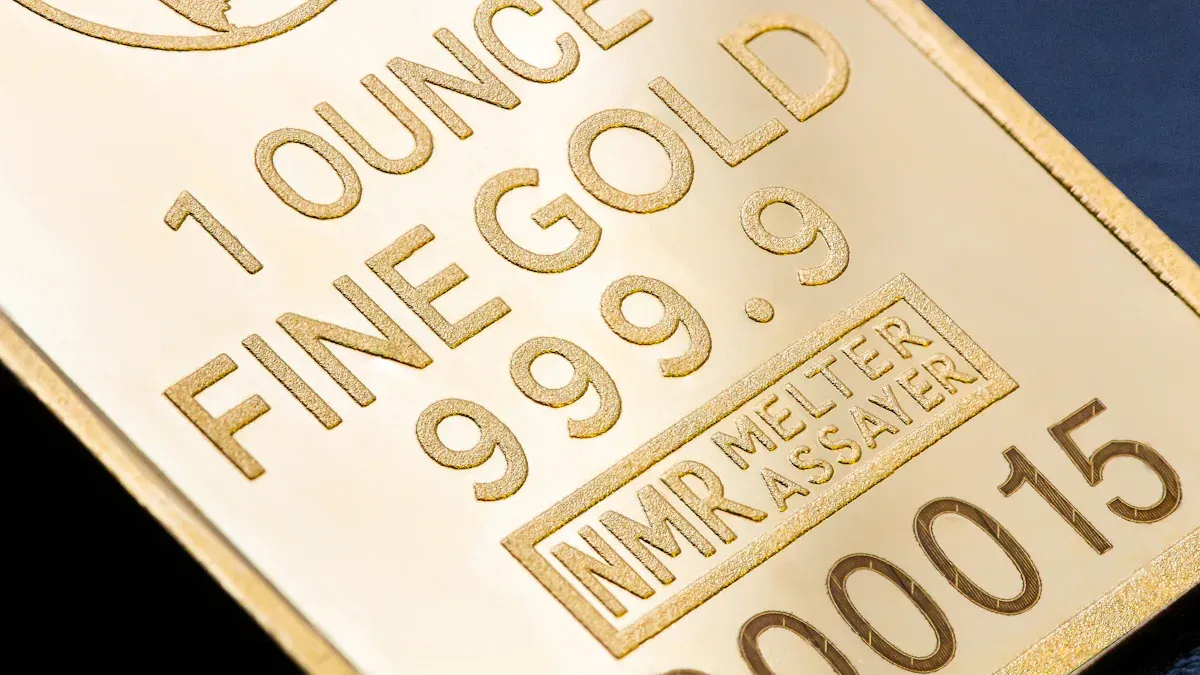
When you compare different karats of gold, you notice clear differences in purity, color, and durability. 18k gold contains 75% real gold, giving you a strong balance between luxury and strength for daily gold jewelry. 21k and higher karat weight golds offer a richer yellow color but feel softer and may deform more easily. 24k gold stands out as the purest but ranks lowest in durability, making it best for investment or special occasions. You often find that lower karat gold costs less, while higher karat weight increases price and purity. The best karat of gold depends on your needs—choose lower karat weight for active wear, higher for value and beauty.
Key Takeaways
18k gold offers a strong balance of 75% pure gold and durability, making it ideal for daily wear and fine jewelry.
21k gold contains about 87.5% pure gold, giving it a richer yellow color but softer feel, best for special occasions.
24k gold is nearly 100% pure and shines with a bright yellow color but is the softest, suited mainly for investment or rare jewelry.
Higher karat gold costs more and looks more vibrant, but lower karat gold lasts longer and resists scratches better.
Choose your gold karat based on your lifestyle: 18k for everyday use, 21k for traditional or special pieces, and 24k for investment or collectibles.
Karat Meaning
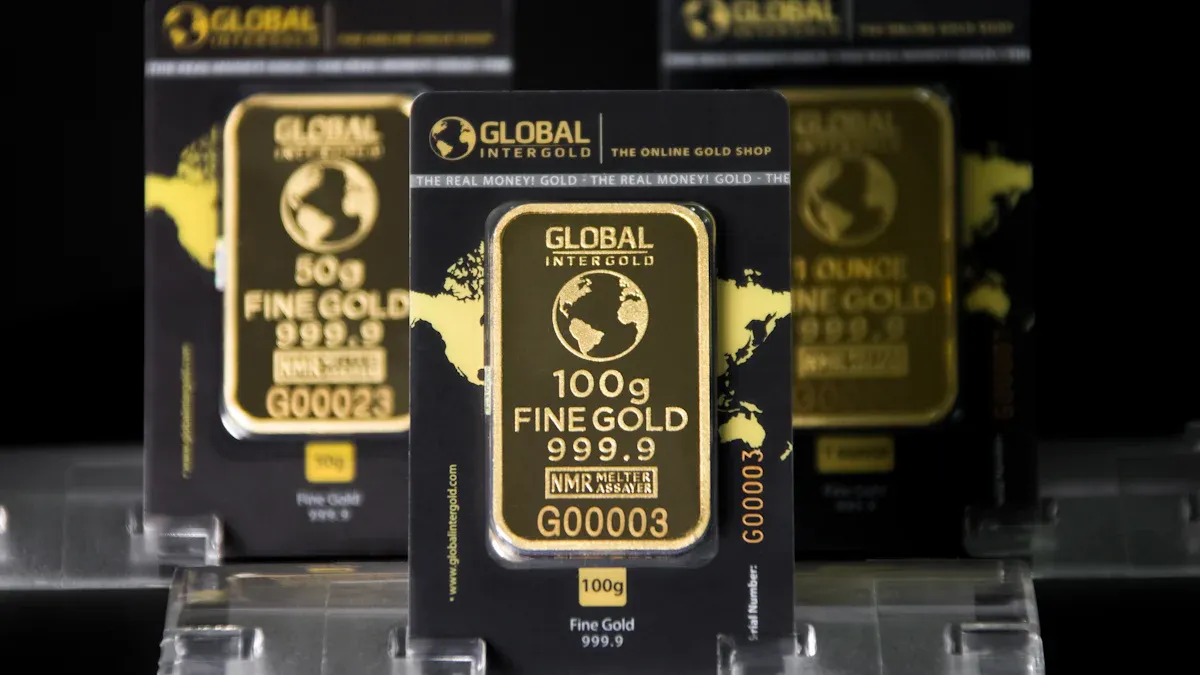
Definition
When you look at gold jewelry, you often see numbers like 18k, 21k, or 24k. These numbers show the karat of the gold. The karat system measures how much real gold is in a piece compared to other metals. One karat means one part out of 24 parts is pure gold. So, 24 karat gold is pure gold, while lower karats have more mixed-in metals like copper, silver, or zinc. This system started in ancient times and is still used worldwide to show the gold content in jewelry and coins.
You can trust the karat markings because they follow strict rules. In the United States, the law says gold products must have the correct karat weight marked clearly. For example, if you see “18k” on a ring, you know it has 18 parts gold out of 24. The law also protects you from fake or misleading markings. Only genuine gold can have these marks, and the jewelry must meet minimum standards for durability and gold content.
Tip: Always check for a hallmark or stamp inside your jewelry. This mark shows the karat and sometimes the maker or assay office. It helps you know you are buying genuine gold.
Purity Levels
You can use the karat system to compare different karats of gold. Each karat tells you the percentage of pure gold in the item. For example, 18k gold has 75% pure gold, while 21k gold has about 87.5%. The highest, 24k gold, is almost 100% pure. Lower karat gold, like 10k or 14k, has less gold content and more other metals. The purity of gold affects its color, strength, and price.
To check the purity of gold, jewelers use several methods. You might see hallmarks like “750” for 18k or “999” for 24k. These numbers show the gold content using the millesimal fineness system. Some jewelers use acid tests, electronic testers, or even X-ray machines to make sure the gold is real. Buying from a trusted source helps you get the right karat gold and the best value.
You should always know the karat weight and gold content before you buy. This helps you choose the right gold for your needs, whether you want higher karat gold for beauty or lower karat gold for daily use.
18k Gold
Composition
When you choose 18k gold, you get a blend of 75% pure gold and 25% other metals. Jewelers often mix in copper, silver, zinc, or nickel to create this alloy. This mix increases the strength of the gold and helps it keep its shape. The karat system shows you the gold content, with 18k gold meaning 18 parts gold out of 24. Industry experts confirm that this ratio is standard for gold jewelry. The added metals make 18k gold more practical for daily wear than higher karat gold, which can be too soft.
Color
You will notice that 18k gold has a rich, warm yellow color. The high gold content gives it a deep shine, but the other metals can slightly change the shade. Sometimes, you might see a hint of rose or white, depending on the alloy mix. The color of 18k gold stands out more than lower karat gold, but it is not as bright as pure 24k gold. Many people love this balanced look because it feels both luxurious and classic.
Durability
18k gold offers a good balance between beauty and strength. The extra metals make it harder than 24k gold, so it resists bending and scratching better. However, it is still softer than 14k or 10k gold, which have even more alloy content. You can see how 18k gold compares in this chart:
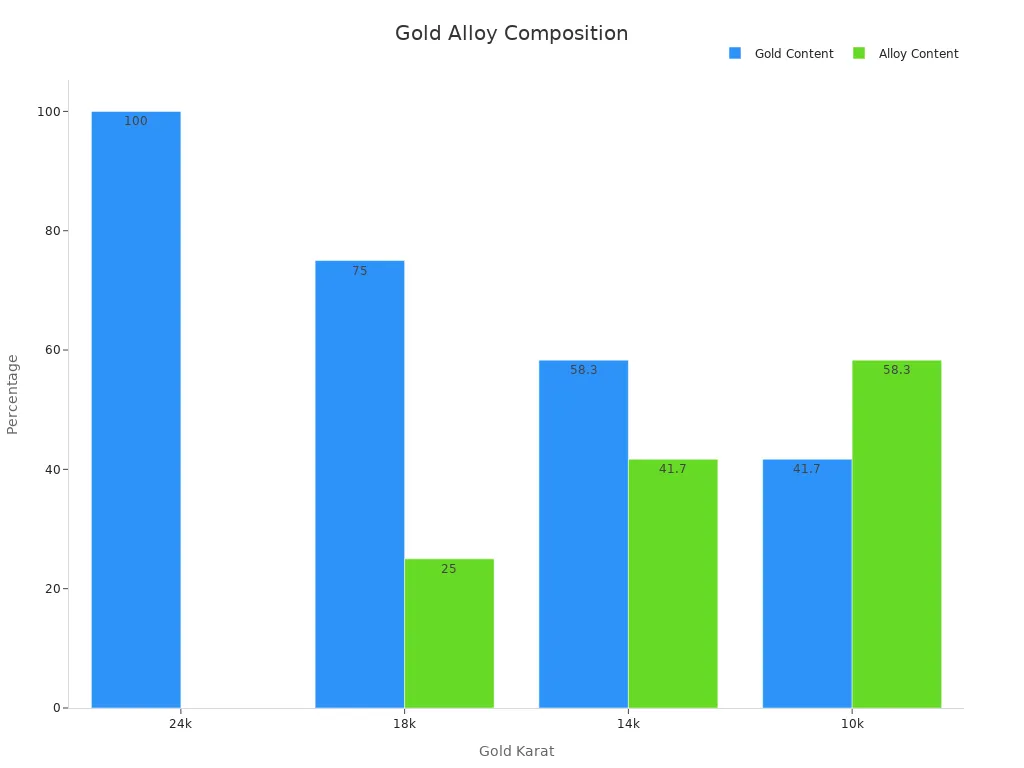
The chart shows that as the gold content goes down, durability goes up. 18k gold is strong enough for most gold jewelry, but you may need to polish it sometimes if you wear it every day.
Uses
You will find 18k gold in many types of gold jewelry. Its mix of purity and strength makes it a favorite for:
Bracelets and necklaces for daily wear
Upscale fine jewelry pieces
Many people pick 18k gold because it offers both luxury and practicality. The karat weight gives you a high level of gold content, while the alloy metals help your jewelry last longer. Trusted jewelers often recommend 18k gold for those who want a rich look without giving up durability. If you want gold jewelry that shines and stands up to daily life, 18k gold is a smart choice.
21k Gold
Composition
When you look at 21k gold, you see a metal that contains about 87.5% pure gold. Jewelers mix this high gold content with other metals, such as copper or silver, to create a strong but beautiful alloy. The karat weight of 21k gold means it has 21 parts gold out of 24. This higher karat gold gives you more purity than 18k gold, but it still keeps enough strength for making gold jewelry. You get a piece that feels luxurious and valuable.
Color
You will notice that 21k gold has a vibrant, deep yellow color. The higher gold content creates a richer and brighter shine than 18k gold. Many people love this color because it looks close to pure gold. The color stands out in gold jewelry, making it popular for special pieces. If you want your jewelry to have a bold and classic gold look, 21k karat gold is a great choice.
Durability
21k gold offers moderate durability. The higher karat weight means more gold and less alloy, so the metal feels softer than 18k gold. You need to take care when wearing 21k gold jewelry every day. It can bend or scratch more easily than lower karat gold. However, it still holds up better than 24k gold, which is the softest. If you want a balance between purity and strength, 21k karat gold gives you that middle ground.
Note: Always store your higher karat gold jewelry in a safe place to avoid scratches and dents.
Uses
You often find 21k gold in fine jewelry, especially in regions where people value higher purity. Jewelers use it for necklaces, earrings, and bangles that you wear on special occasions. Some people choose 21k gold for wedding jewelry because of its rich color and high gold content. If you want gold jewelry that shows off both beauty and value, 21k karat gold is a smart pick. You get a piece that feels special and looks stunning, but you should wear it with care to keep it looking its best.
24k Gold
Composition
You get the highest level of purity when you choose 24k gold. This type of gold is 99.9% pure, which means it contains almost no other metals. The karat system marks 24k as the top, with all 24 parts made of gold. Jewelers and industry experts use the fineness system to show this purity, often marking it as “999” on bars and coins. Certification from trusted organizations, like BIS hallmarking, confirms the gold content and quality. You can trust that 24k karat gold gives you the purest form available.
Color
24k gold stands out because of its bright, vibrant yellow color. The high gold content creates a shine that looks richer than any lower karat gold. You can see the difference in this chart, which compares the color and purity of different karats:
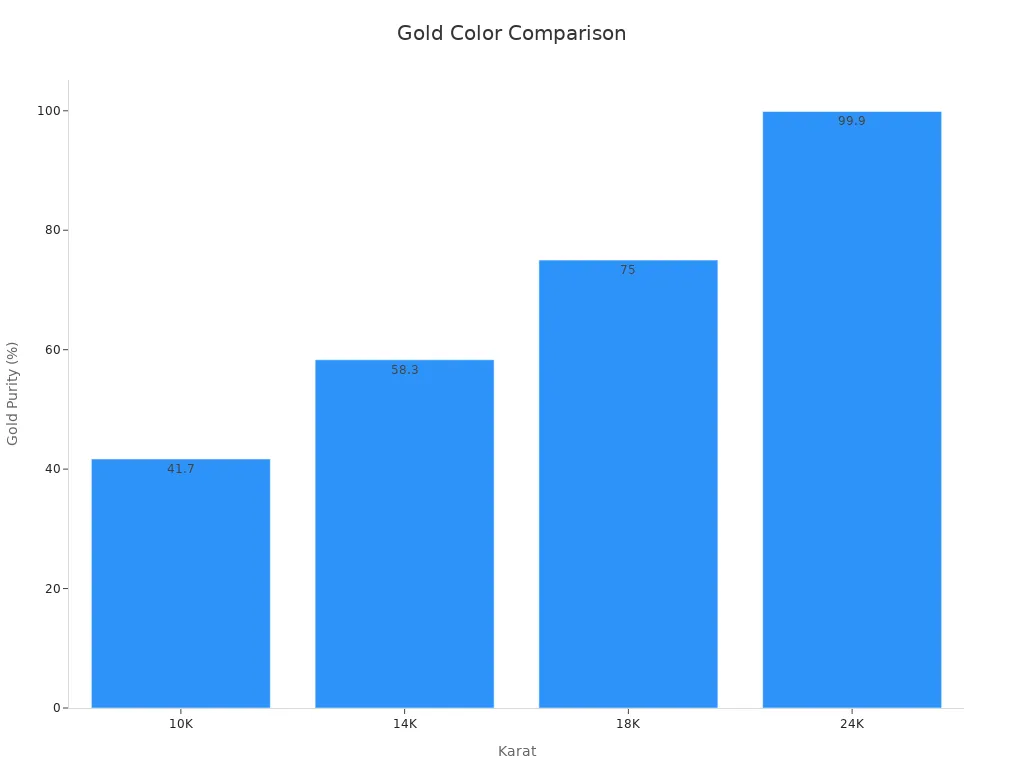
The table below also shows how 24k gold has the most intense yellow hue:
Karat | Gold Purity | Yellow Gold Color Description |
|---|---|---|
10K | 41.7% | Light yellow (less saturated) |
14K | 58.3% | Warm yellow |
18K | 75% | Rich, deep yellow |
24K | 99.9% | Bright, vibrant yellow |
You will notice that 24k karat gold always looks the most luxurious and eye-catching.
Durability
You should know that 24k gold is the softest type of gold. The high purity makes it easy to bend or scratch. This softness means 24k karat gold is not a good choice for everyday gold jewelry. If you wear it often, it can lose its shape or get damaged. Lower karat gold, like 18k or 22k gold, is much stronger because it has more alloy metals. You need to handle 24k gold with care to keep it looking perfect.
Tip: Store your 24k gold pieces in a safe place and avoid wearing them during daily activities.
Uses
You will mostly find 24k gold in investment products, such as gold bars and coins. Investors and collectors prefer this karat gold because of its high purity and value. Central banks also keep 24k gold in their reserves. Some cultures use 24k gold for special occasion jewelry, but it is rare because of its softness. You may also see 24k gold used in electronics, where high purity is important. If you want gold for investment or as a collectible, 24k karat gold is the best choice.
Comparison

Summary Table
You can quickly compare different karats of gold using the table below. This table shows the main features of 18k gold, 21k gold, and 24k gold. You will see differences in gold purity, color, durability, price, and typical uses. This summary helps you decide which type fits your needs best.
Karat | Gold Purity (%) | Color Description | Durability | Price Level | Typical Uses |
|---|---|---|---|---|---|
18k gold | 75 | Rich, deep yellow | Durable | High | Daily wear, engagement rings, fine jewelry |
21k gold | 87.5 | Vibrant, classic yellow | Moderately durable | Premium | Traditional jewelry, special occasions |
24k gold | 99.9 | Bright, vibrant yellow | Softest | Most expensive | Investment, collector’s items, rare jewelry |
You can also see the difference in gold purity for each karat in the chart below:
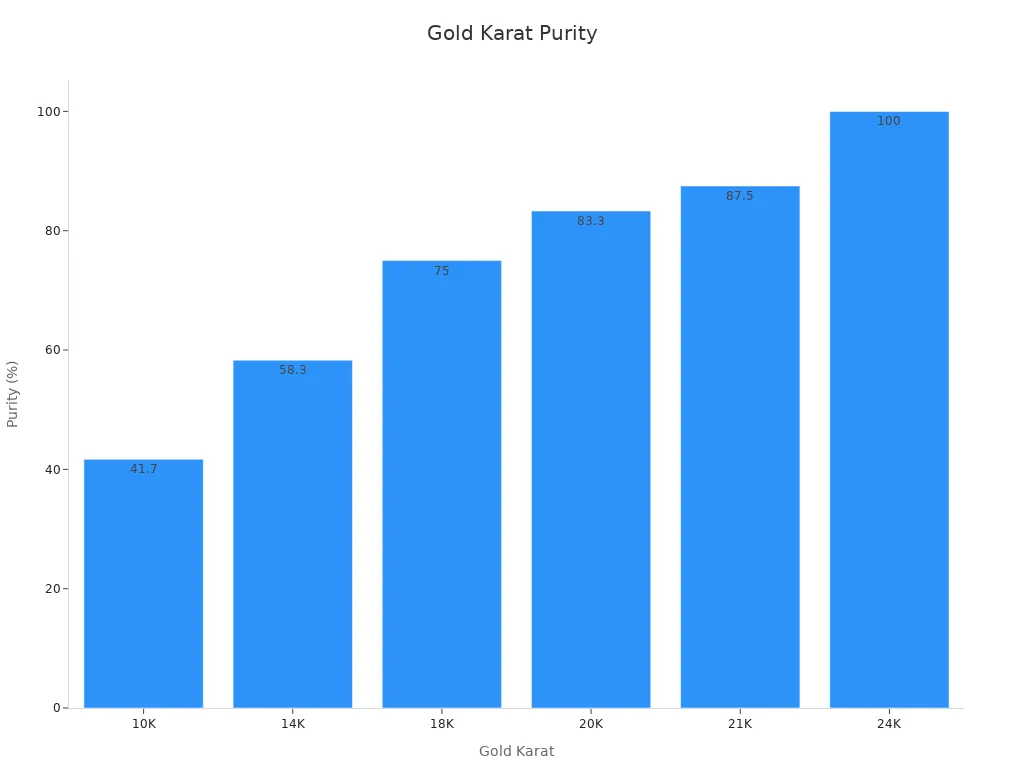
Statistical studies show that people notice clear differences in color, shine, and durability when comparing different karats. Researchers used repeated measures and group comparisons to confirm that each karat gold type stands out in both appearance and performance. These findings help you trust the differences shown in the table.
Key Differences
You will notice several key differences when you compare 18k gold, 21k gold, and 24k gold. Each type has its own strengths and best uses.
Purity: 24k gold has the highest purity. 21k gold comes next, followed by 18k gold. Higher purity means a brighter yellow color but less strength.
Durability: 18k gold is the most durable among these three. 21k gold is softer but still strong enough for many types of gold jewelry. 24k gold is the softest and can bend or scratch easily.
Color: 24k gold shines with a bright, vibrant yellow. 21k gold looks rich and classic. 18k gold has a deep yellow that feels both elegant and practical.
Price: 24k gold costs the most because of its high gold content. 21k gold has a premium price. 18k gold is still expensive but offers a better balance between cost and durability.
Uses: You will find 18k gold in daily wear and fine jewelry. 21k gold works well for traditional pieces and special occasions. 24k gold is best for investment and collector’s items.
Researchers have used detailed studies and consumer data to confirm these differences. They found that people rate each karat gold type differently for beauty, strength, and value. These results match what you see in the summary table.
Choosing the Right Karat
You can use a simple decision-making framework to pick the best karat of gold for your needs. Experts suggest that you look at your lifestyle, budget, and what you want from your gold jewelry.
If you want gold jewelry for daily wear, choose 18k gold. It gives you good durability and a rich look.
If you want something more traditional or for special occasions, 21k gold offers a beautiful color and higher purity. You should handle it with care.
If you want to invest or collect, 24k gold is the best karat of gold. It has the highest purity and value, but it is not strong enough for everyday use.
Multi-criteria decision analysis helps you weigh factors like price, gold purity, and durability. This method lets you see the trade-offs and pick the gold type that matches your needs. You can also compare value for money, especially if you have a budget.
Tip: Think about how often you will wear your gold jewelry and how much you want to spend. The best karat of gold for you depends on your lifestyle and what matters most to you.
You can use the summary table and these guidelines to make a smart choice. Each karat gold type has its own benefits, so you can find one that fits your style and needs.
You now understand the essential differences between 18k, 21k, and 24k gold. Each type of gold offers unique benefits. If you want the best karat of gold for daily wear, 18k gold gives you strength and beauty. For investment or special occasions, 24k gold stands out. Use the comparison table to help you decide which is the best karat of gold for your needs. Your choice depends on how you plan to use your gold.
FAQ
What does karat mean in gold jewelry?
Karat shows how much pure gold is in your jewelry. Higher karat means more gold and less other metal. For example, 24k gold is almost pure gold. Lower karat gold has more mixed metals for strength.
Can you wear 24k gold every day?
You should avoid wearing 24k gold daily. Pure gold bends and scratches easily. Choose 18k gold or 21k gold for jewelry you want to wear often. These types last longer and keep their shape better.
Why does gold jewelry come in different colors?
Jewelers mix gold with other metals to change its color. Copper gives gold a reddish tone. Silver or palladium makes gold look whiter. The mix also affects how strong the jewelry feels.
How do you know if your gold is real?
Look for a stamp or hallmark on your jewelry. This mark shows the karat and sometimes the maker. You can also ask a jeweler to test your gold using special tools or machines.



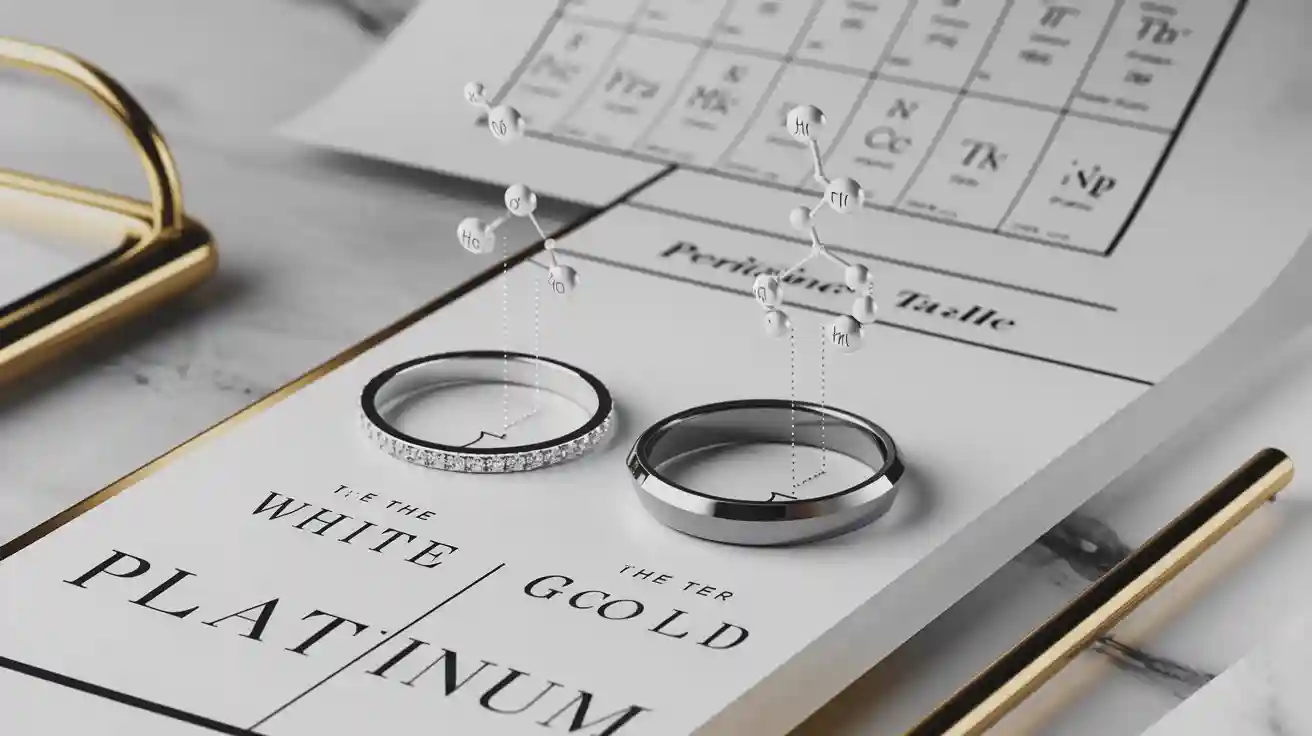



WhatsApp
Scan the QR Code to start a WhatsApp chat with us.